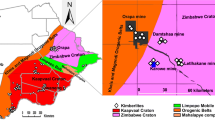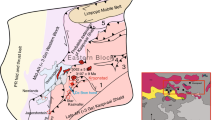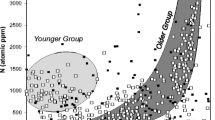Abstract
We studied a suite of Cullinan diamonds (<0.3 ct) with mineral inclusions, which comprised 266 Type I and 75 blank Type II (<20 ppm N) diamonds, as classified by infrared spectroscopy. More than 90% (n = 68) of Type II diamonds do not luminesce. In contrast, 51.9% (n = 177) of Type I diamonds luminesce, with blue colors of different intensity. Carbon isotopic compositions of Type I and II diamonds are similar, with δ13CVPDB ranging from −2.1 to −7.7‰ for Type I diamonds (n = 25), and from −1.3 to −7.8‰ for Type II diamonds (n = 20). The Type II diamonds are sourced from three parageneses, lithospheric lherzolitic (45%), lithospheric eclogitic (33%), and sublithospheric mafic (22%). The lherzolitic suite contains Cr-pyrope, forsterite, enstatite, clinopyroxene and Cr-spinel formed at 1090–1530 °C and P = 4.6–7.0 GPa. Lithospheric eclogitic diamonds containing garnet, omphacite, kyanite and coesite comprise 33% of Type II diamonds. The sublithospheric mafic paragenesis is mainly represented by Cr-free majorite, various CaSiO3 phases and omphacite equilibrated at 11.6–26 GPa, in the transition zone and the lower mantle. The lherzolitic paragenesis predominates in Type II diamonds, whereas 79% Type I diamonds are sourced from eclogites. The higher incidence of sublithospheric inclusions was found in Type II diamonds, 22% against 6% in Type I diamonds. The similarity of the mineral parageneses and C isotopic compositions in the small Cullinan Type II and Type I diamonds indicate the absence of distinct mantle processes and carbon sources for formation of studied Type II diamonds. The parent rocks and the carbon sources generally vary for Type II diamonds within a kimberlite and between kimberlites.









Similar content being viewed by others
References
Arai H (2010) A function for the R programming language to recast garnet analyses into end-members: Revision and porting of Muhling and Griffin’s method. Comput Geosci 36:406–409
Araujo DP, Gaspar JC, Bulanova GP, Smith CB, Kohn SC, Walter MJ, Hauri EH (2013) Juina diamonds from kimberlites and alluvials: A comparison of morphology, spectral characteristics and carbon isotope composition. In: Proceedings of 10th International Kimberlite Conference. Springer India, New Delhi, pp 255–269
Banas A, Stachel T, Muehlenbachs K, McCandless TE (2007) Diamonds from the Buffalo Head Hills, Alberta: Formation in a non-conventional setting. Lithos 93:199–213
Banas A, Stachel T, Stern R, Allan A, Freeman L (2017) Can microdiamonds be used to predict the distribution of large Type IIa macrodiamonds? A case study at the Letseng mine. In: 11th International Kimberlite Conference Extended Abstract. Gaborone, no 11IKC-4891
Borges MPAC, Moura MA, Lenharo SLR, Smith CB, Araujo DP (2016) Mineralogical characterization of diamonds from Roosevelt Indigenous Reserve, Brazil, using non-destructive methods. Lithos 265:182–198
Bowen DC, Ferraris RD, Palmer CE, Ward JD (2009) On the unusual characteristics of the diamonds from Letšeng-la-Terae kimberlites, Lesotho. Lithos 112:767–774
Boyd FR, Pokhilenko NP, Pearson DG, Mertzman SA, Sobolev NV, Finger LW (1997) Composition of the Siberian cratonic mantle: evidence from Udachnaya peridotite xenoliths. Contrib Mineral Petrol 128:228–246
Breeding CM, Shigley JE (2009) The “Type” classification system of diamonds and its importance in gemology. Gems Gemol 45:96–111
Brey GP, Köhler T (1990) Geothermobarometry in four-phase lherzolites II. New thermobarometers, and practical assessment of existing thermobarometers. J Petrol 31:1353–1378
Bulanova GP, Walter MJ, Smith CB, Kohn SC, Armstrong LS, Blundy J, Gobbo L (2010) Mineral inclusions in sublithospheric diamonds from Collier 4 kimberlite pipe, Juina, Brazil: subducted protoliths, carbonated melts and primary kimberlite magmatism. Contrib Mineral Petrol 160:489–510
Bulanova GP, Smith CB, Kohn SC, Speich L (2017) Natural diamond growth conditions recorded by their internal structures. In: 11th International Kimberlite Conference Extended Abstract. Gaborone, No. 11IKC-4523
Burnham AD, Bulanova GP, Smith CB, Whitehead SC, Kohn SC, Gobbo L, Walter MJ (2016) Diamonds from the Machado River alluvial deposit, Rondônia, Brazil, derived from both lithospheric and sublithospheric mantle. Lithos 265:199–213
Bussweiler Y, Brey GP, Pearson DG, Stachel T, Stern RA, Hardman MF, Kjarsgaard BA, Jackson SE (2017) The aluminum-in-olivine thermometer for mantle peridotites — Experimental versus empirical calibration and potential applications. Lithos 272–273:301–314
Cartigny P (2005) Stable isotopes and the origin of diamond. Elements 1:79–84
Cartigny P, Harris JW, Javoy M (2001) Diamond genesis, mantle fractionations and mantle nitrogen content: a study of δ13C–N concentrations in diamonds. Earth Planet Sci Lett 185:85–98
Cartigny P, Farquhar J, Thomassot E, Harris JW, Wing B, Masterson A, McKeegan K (2009) A mantle origin for Paleoarchean peridotitic diamonds from the Panda kimberlite, Slave Craton: Evidence from 13C-, 15N- and 33,34S-stable isotope systematics. Lithos 112:852–864
D’Haenens-Johansson UFS, Smith EM, Smit KV, Wang W, Moses TM (2017) The 812-Carat Pure type IaB constellation diamond from Karowe–Part of an even larger rough? In: 11th International Kimberlite Conference Extended Abstract. Gaborone, No. 11IKC-4611
Day HW (2012) A revised diamond-graphite transition curve. Am Mineral 97:52–62
De Corte K, Cartigny P, Shatsky V, Sobolev NV, Javoy M (1998) Evidence of fluid inclusions in metamorphic microdiamonds from the Kokchetav massif, northern Kazakhstan. Geochim Cosmochim Acta 62:3765–3773
De Hoog JCM, Gall L, Cornell DH (2010) Trace-element geochemistry of mantle olivine and application to mantle petrogenesis and geothermobarometry. Chem Geol 270:196–215
Deines P, Harris JW (1995) Sulfide inclusion chemistry and carbon isotopes of African diamonds. Geochim Cosmochim Acta 59:3173–3188
Deines P, Gurney J, Harris J (1984) Associated chemical and carbon isotopic composition variations in diamonds from Finsch and Premier kimberlite, South Africa. Geochim Cosmochim Acta 48:325–342
Deines P, Harris J, Spear P, Gurney J (1989) Nitrogen and 13C content of Finsch and Premier diamonds and their implications. Geochim Cosmochim Acta 53:1367–1378
Dymshits A, Sharygin I, Litasov K, Shatskiy A, Gavryushkin P, Ohtani E, Suzuki A, Funakoshi K (2015) In situ observation of the pyroxene-majorite transition in Na2MgSi5O12 using synchrotron radiation and Raman spectroscopy of Na-majorite. Am Mineral 100:378–384
Eaton-Magana S, Breeding CM (2016) An introduction to photoluminescence spectroscopy for diamond and its applications in gemology. Gems Gemol 52:2–17
Gaillou E, Post JE, Rost D, Butler JE (2012) Boron in natural type IIb blue diamonds: Chemical and spectroscopic measurements. Am Mineral 97:1–18
Goss JP, Briddon PR, Hill V, Jones R, Rayson MJ (2014) Identification of the structure of the 3107 cm −1 H-related defect in diamond. J Phys-Condens Mat 26:145801
Grütter HS, Gurney JJ, Menzies AH, Winter F (2004) An updated classification scheme for mantle-derived garnet, for use by diamond explorers. Lithos 77:841–857
Gurney JJ, Helmstaedt HH (2012) The origins of Type IIa diamonds and their enhanced economic significance. In: 10th International Kimberlite Conference, Short Abstract. No. 10IKC-123, pp 247-248
Gurney JJ, Zweistra P (1995) The interpretation of the major element compositions of mantle minerals in diamond exploration. J Geochem Explor 53:293–309
Hasterok D, Chapman DS (2011) Heat production and geotherms for the continental lithosphere. Earth Planet Sci Lett 307:59–70
Hayman PC, Kopylova MG, Kaminsky FV (2005) Lower mantle diamonds from Rio Soriso (Juina area, Mato Grosso, Brazil). Contrib Mineral Petrol 149:430–445
Hirose K, Fei Y (2002) Subsolidus and melting phase relations of basaltic composition in the uppermostlower mantle. Geochim Cosmochim Acta 66:2099–2108
Johnson CN, Stachel T, Muehlenbachs K, Stern RA, Armstrong JP, EIMF (2012) The micro−/macro-diamond relationship: A case study from the Artemisia kimberlite (Northern Slave Craton, Canada). Lithos 148:86–97
Katsura T, Yoneda A, Yamazaki D, Yoshino T, Ito E (2010) Adiabatic temperature profile in the mantle. Phys Earth Planet Inter 183:212–218
Khokhryakov AF, Palyanov YN, Kupriyanov IN, Borzdov YM, Sokol AG (2014) Effect of nitrogen impurity on the dislocation structure of large HPHT synthetic diamond crystals. J Cryst Growth 386:162–167
Kiseeva ES, Yaxley GM, Stepanov AS, Tkalčić H, Litasov KD, Kamenetsky VS (2013) Metapyroxenite in the mantle transition zone revealed from majorite inclusions in diamonds. Geology 41:883–886
Korolev NM, Kopylova M, Bussweiler Y, Pearson DG, Gurney JJ, Davidson J (2018) The uniquely high-temperature character of Cullinan diamonds: A signature of the Bushveld mantle plume? Lithos 304–307:362–373
Kosman CW (2015) Cretaceous mantle of the Congo craton: Evidence from mineral and fluid inclusions in Kasai alluvial diamonds. MSc Thesis, The University of British Columbia
Kosman CW, Kopylova MG, Stern RA, Hagadorn JW, Hurlbut JF (2016) Cretaceous mantle of the Congo craton: Evidence from mineral and fluid inclusions in Kasai alluvial diamonds. Lithos 265:42–56
McCallum ME, Huntley PM, Falk RW, Otter ML (1994) Morphological, resorption and etch feature trends of diamonds from kimberlite populations within the Colorado-Wyoming State Line district, USA. In: Proceedings of the 5th International Kimberlite Conference Vol. 2, pp 32–50
McDade P, Harris JW (1999) Syngenetic inclusion-bearing diamonds from Letseng-la-Terai, Lesotho. In: Proceedings of the VIIth International Kimberlite Conference. Red Roof Design Cape Town. Vol. 2, pp 557–565
Milledge HJ, Mendelssohn MJ, Seal M, Rouse JE, Swart PK, Pillinger CT (1983) Carbon isotopic variation in spectral type II diamonds. Nature 303:791–792
Moore AE (2009) Type II diamonds: Flamboyant megacrysts? S Afr J Geol 112:23–38
Moore AE (2014) The origin of large irregular gem-quality type II diamonds and the rarity of blue type IIb varieties. S Afr J Geol 117:219–236
Nakamura D (2009) A new formulation of garnet-clinopyroxene geothermometer based on accumulation and statistical analysis of a large experimental data set. J Metamorph Geol 27:495–508
Nestola F, Burnham AD, Peruzzo L, Tauro L, Alvaro M, Walter MJ, Gunter M, Anzolini C, Kohn SC (2016) Tetragonal Almandine-Pyrope Phase, TAPP: finally a name for it, the new mineral jeffbenite. Mineral Mag 80:1219–1232
Nestola F, Korolev N, Kopylova M, Rotiroti N, Pearson DG, Pamato M, Alvaro M, Gurney J, Moore A, Davidson J, Peruzzo L (2018) CaSiO3 perovskite in diamond indicates the recycling of oceanic crust into the lower mantle. Nature 555:237–241
Nickel KG, Green DH (1985) Empirical geothermobarometry for garnet peridotites and implications for the nature of the lithosphere, kimberlites and diamonds. Earth Planet Sci Lett 73:158–170
Nimis P, Grütter H (2010) Internally consistent geothermometers for garnet peridotites and pyroxenites. Contrib Mineral Petrol 159:411–427
Nimis P, Taylor WR (2000) Single clinopyroxene thermobarometry for garnet peridotites. Part I. Calibration and testing of a Cr-in-Cpx barometer and an enstatite-in-Cpx thermometer. Contrib Mineral Petrol 139:541–554
O’Neill HSC, Wood BJ (1979) An experimental study of Fe-Mg partitioning between garnet and olivine and its calibration as a geothermometer. Contrib Mineral Petrol 70:59–70
Palot M, Pearson DG, Stern RA, Stachel T, Harris JW (2013) Multiple growth events, processes and fluid sources involved in diamond genesis: A micro-analytical study of sulphide-bearing diamonds from Finsch mine, RSA. Geochim Cosmochim Acta 106:51–70
Palot M, Pearson DG, Stachel T, Stern RA, Le Pioufle A, Gurney JJ, Harris JW (2017) The transition zone as a host for recycled volatiles: Evidence from nitrogen and carbon isotopes in ultra-deep diamonds from Monastery and Jagersfontein (South Africa). Chem Geol 466:733–749
Pattison DRM, Levinson AA (1995) Are euhedral microdiamonds formed during ascent and decompression of kimberlite magma? Implications for use of microdiamonds in diamond grade estimation. Appl Geochem 10:725–738
Pearson DG, Canil D, Shirey SB (2003) Mantle samples included in volcanic rocks: Xenoliths and diamonds. In: Richard W (ed) Treatise on Geochemistry, vol 2. Elsevier, pp 171–275
Robertson R, Fox JJ, Martin AE (1934) Two types of diamond. Philos Trans R Soc London Ser A, Contain Pap a Math or Phys Character 232:463–535
Shirey SB, Cartigny P, Frost DJ, Keshav S, Nestola F, Nimis P, Pearson DG, Sobolev NV, Walter MJ (2013) Diamonds and the geology of mantle carbon. In: Hazen RM, Jones AP, Baross JA (eds) Carbon in Earth. Rev Mineral Geochem vol. 75. Miner Soc Am, Chantilly, pp 355–421. https://doi.org/10.2138/rmg.2013.75.12
Smart KA, Chacko T, Stachel T, Muehlenbachs K, Stern RA, Heaman LM (2011) Diamond growth from oxidized carbon sources beneath the Northern Slave Craton, Canada: A δ13C–N study of eclogite-hosted diamonds from the Jericho kimberlite. Geochim Cosmochim Acta 75:6027–6047
Smit KV, Stachel T, Stern RA (2014) Diamonds in the Attawapiskat area of the Superior craton (Canada): evidence for a major diamond-forming event younger than 1.1 Ga. Contrib Mineral Petrol 167:962
Smith EM, Kopylova MG (2014) Implications of metallic iron for diamonds and nitrogen in the sublithospheric mantle. Can J Earth Sci 51:510–516
Smith EM, Shirey SB, Nestola F, Bullock ES, Wang J, Richardson SH, Wang W (2016) Large gem diamonds from metallic liquid in Earth’s deep mantle. Science 354:1403–1405
Smith EM, Shirey SB, Wang W (2017) The very deep origin of the world’s biggest diamonds. Gems Gemol 53:388–403
Sobolev NV, Lavrent’ev YG, Pokhilenko NP, Usova LV (1973) Chrome-rich garnets from the kimberlites of yakutia and their parageneses. Contrib Mineral Petrol 40:39–52
Speich L, Kohn SC, Wirth R, Bulanova GP, Smith CB (2017) The relationship between platelet size and the B′ infrared peak of natural diamonds revisited. Lithos 278–281:419–426
Stachel T, Harris JW (2008) The origin of cratonic diamonds — Constraints from mineral inclusions. Ore Geol Rev 34:5–32
Sutherland GBBM, Blackwell DE, Simeral WG (1954) The problem of the two types of diamond. Nature 174:901–904
Tappert R, Tappert MC (2011) Diamonds in nature: a guide to rough diamonds. Springer Science & Business Media
Taylor WR (1998) An experimental test of some geothermometer and geobarometer formulations for upper mantle peridotites with application to the thermobarometry of fertile lherzolite and garnet websterite. Neues Jb Miner Abh 172:381–408
Taylor LA, Neal CR (1989) Eclogites with oceanic crustal and mantle signatures from the Bellsbank kimberlite, South Africa, Part I: Mineralogy, petrography, and whole rock chemistry. J Geol 97:551–567
Viljoen F, Dobbe R, Smit B, Thomassot E, Cartigny P (2004) Petrology and geochemistry of a diamondiferous lherzolite from the Premier diamond mine, South Africa. Lithos 77:539–552
Viljoen KS, Dobbe R, Smit B (2009) Geochemical processes in peridotite xenoliths from the Premier diamond mine, South Africa: Evidence for the depletion and refertilisation of subcratonic lithosphere. Lithos 112:1133–1142
Wijbrans CH, Rohrbach A, Klemme S (2016) An experimental investigation of the stability of majoritic garnet in the Earth’s mantle and an improved majorite geobarometer. Contrib Mineral Petrol 171:50
Zaitsev AM (2013) Optical properties of diamond: A data handbook. Springer Science & Business Media
Acknowledgements
We thank Yunbin Guan and Branko Deljanin for help with diamond analyses. We are indebted to Antony Burnham, an anonymous reviewer and handling editor Oded Navon for constructive comments that helped to improve the manuscript. This study was funded by the Dr. Eduard Gübelin Association through the 2015 Dr. Eduard Gübelin research scholarship to N.K. and by an NSERC Discovery Grant (04629) to M.K.
Author information
Authors and Affiliations
Corresponding author
Additional information
Editorial handling: O. Navon
Electronic supplementary material
ESM 1
(7Z 2286 kb)
Rights and permissions
About this article
Cite this article
Korolev, N., Kopylova, M., Gurney, J.J. et al. The origin of Type II diamonds as inferred from Cullinan mineral inclusions. Miner Petrol 112 (Suppl 1), 275–289 (2018). https://doi.org/10.1007/s00710-018-0601-z
Received:
Accepted:
Published:
Issue Date:
DOI: https://doi.org/10.1007/s00710-018-0601-z




